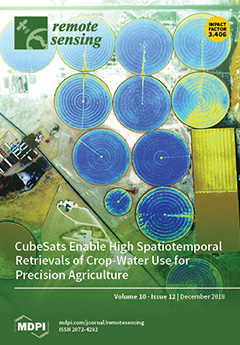1
Laboratorio de Espectro-Radiometría y Teledetección Ambiental (SpecLab), Consejo Superior de Investigaciones Científicas (CSIC), Albasanz 26-28, 28037 Madrid, Spain
2
Max Planck Institute for Biogeochemistry, Hanks Knöll Straße 10, D-07745 Jena, Germany
3
Departamento de Medio Ambiente, Instituto Nacional de Investigación y Tecnología Agraria y Alimentaria (INIA), Ctra. Coruña, Km 7.5, 28040 Madrid, Spain
4
INDEHESA-Forest Research Group, Universidad de Extremadura, 10600 Plasencia, Spain
5
Departamento de Geografía y Ordenación del Territorio, Universidad de Zaragoza, Pedro Cerbuna, 12, 50009 Zaragoza, Spain
6
Departamento de Geología, Geografía y Medio Ambiente, Universidad de Alcalá, Colegios 2, 28801 Alcalá de Henares, Spain
7
Department of Geography, Swansea University, Swansea SA2 8PP, UK
8
Center for Spatial Technologies and Remote Sensing (CSTARS), University of California, Davis, One Shields Avenue, 139 Veihmeyer Hall, Davis, CA 95616, USA
Abstract
The 3-D Radiative Transfer Model (RTM) FLIGHT can represent scattering in open forest or savannas featuring underlying bare soils. However, FLIGHT might not be suitable for multilayered tree-grass ecosystems (TGE), where a grass understory can dominate the reflectance factor (
RF) dynamics
[...] Read more.
The 3-D Radiative Transfer Model (RTM) FLIGHT can represent scattering in open forest or savannas featuring underlying bare soils. However, FLIGHT might not be suitable for multilayered tree-grass ecosystems (TGE), where a grass understory can dominate the reflectance factor (
RF) dynamics due to strong seasonal variability and low tree fractional cover. To address this issue, we coupled FLIGHT with the 1-D RTM PROSAIL. The model is evaluated against spectral observations of proximal and remote sensing sensors: the ASD Fieldspec
® 3 spectroradiometer, the Airborne Spectrographic Imager (CASI) and the MultiSpectral Instrument (MSI) onboard Sentinel-2. We tested the capability of both PROSAIL and PROSAIL+FLIGHT to reproduce the variability of different phenological stages determined by 16-year time series analysis of Moderate Resolution Imaging Spectroradiometer-Normalized Difference Vegetation Index (MODIS-
NDVI). Then, we combined concomitant observations of biophysical variables and
RF to test the capability of the models to reproduce observed
RF. PROSAIL achieved a Relative Root Mean Square Error (
RRMSE) between 6% to 32% at proximal sensing scale. PROSAIL+FLIGHT
RRMSE ranged between 7% to 31% at remote sensing scales.
RRMSE increased in periods when large fractions of standing dead material mixed with emergent green grasses —especially in autumn—; suggesting that the model cannot represent the spectral features of this material. PROSAIL+FLIGHT improves
RF simulation especially in summer and at mid-high view angles.
Full article





